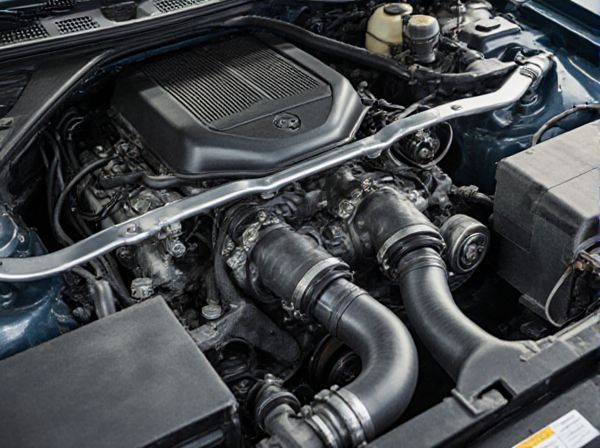
Photo illustration: Single Overhead Camshaft vs Dual Overhead Camshaft
A Single Overhead Camshaft (SOHC) engine uses one camshaft to operate both the intake and exhaust valves, offering simplicity and lower manufacturing costs. Dual Overhead Camshaft (DOHC) engines feature two camshafts per cylinder head, allowing for better airflow, higher engine RPMs, and improved performance. Your choice between SOHC and DOHC will affect engine efficiency, power output, and maintenance requirements depending on your driving needs.
Table of Comparison
| Feature | Single Overhead Camshaft (SOHC) | Dual Overhead Camshaft (DOHC) |
|---|---|---|
| Camshaft Count | One per cylinder head | Two per cylinder head |
| Valve Operation | Typically operates 2 valves per cylinder | Operates 4 or more valves per cylinder |
| Performance | Moderate power and efficiency | Higher power output and better high RPM performance |
| Complexity | Simple design, easier maintenance | More complex design, requires precise tuning |
| Cost | Lower manufacturing and repair cost | Higher manufacturing and maintenance cost |
| Fuel Efficiency | Good efficiency, less optimal valve timing | Better fuel efficiency due to optimized valve control |
| Application | Common in economy and mid-range vehicles | Used in performance and luxury vehicles |
Introduction to Overhead Camshaft Designs
Single Overhead Camshaft (SOHC) designs feature one camshaft per cylinder bank to control both intake and exhaust valves, providing a balance between performance and manufacturing cost. Dual Overhead Camshaft (DOHC) configurations utilize two camshafts per cylinder bank, allowing for improved valve timing precision and higher engine speeds, which enhances power output and efficiency. These camshaft layouts significantly influence engine design, affecting factors such as valve operation, fuel efficiency, and overall performance.
What Is a Single Overhead Camshaft (SOHC)?
A Single Overhead Camshaft (SOHC) engine features one camshaft positioned above the cylinder head, controlling both the intake and exhaust valves with a simpler valvetrain design. This configuration typically offers improved fuel efficiency and lower manufacturing costs compared to Dual Overhead Camshaft (DOHC) engines, while maintaining adequate performance for everyday driving. SOHC engines are commonly found in compact and midsize vehicles due to their balance of power, reliability, and cost-effectiveness.
What Is a Dual Overhead Camshaft (DOHC)?
A Dual Overhead Camshaft (DOHC) engine features two camshafts per cylinder bank, which allows for more precise control of intake and exhaust valves. This design improves engine efficiency, increases power output, and enhances fuel economy compared to a Single Overhead Camshaft (SOHC). Car manufacturers often use DOHC technology to optimize performance in modern vehicles by enabling higher engine speeds and better valve timing accuracy.
Key Differences Between SOHC and DOHC
Single Overhead Camshaft (SOHC) engines utilize one camshaft per cylinder bank to control both intake and exhaust valves, offering simpler design and reduced manufacturing costs. Dual Overhead Camshaft (DOHC) engines feature two camshafts per cylinder bank, allowing independent control of intake and exhaust valves, which enhances engine efficiency, higher RPM potential, and improved performance. SOHC typically provides better fuel economy and lower complexity, while DOHC excels in power output and valve timing precision for advanced tuning.
Performance Comparison: SOHC vs. DOHC
Dual Overhead Camshaft (DOHC) engines typically deliver superior performance compared to Single Overhead Camshaft (SOHC) designs due to better valve timing and increased airflow efficiency. DOHC configurations allow for more precise control of intake and exhaust valves, enabling higher engine speeds and improved horsepower output. SOHC engines, while simpler and often more cost-effective, generally produce less power and have a limited ability to optimize valve timing for performance applications.
Fuel Efficiency and Emissions
Single Overhead Camshaft (SOHC) engines generally offer better fuel efficiency due to simpler valve operation and reduced mechanical friction compared to Dual Overhead Camshaft (DOHC) engines. SOHC designs typically produce lower emissions by optimizing combustion through fewer moving parts and less complex valve timing. In contrast, DOHC engines provide higher performance and power output but often result in increased fuel consumption and higher emission levels due to more aggressive valve operation.
Maintenance and Durability Considerations
Single Overhead Camshaft (SOHC) engines typically offer simpler maintenance due to fewer moving parts, resulting in lower costs and easier access to components. Dual Overhead Camshaft (DOHC) engines, with their multiple camshafts, provide better performance but require more frequent valve adjustments and higher maintenance expertise. In terms of durability, SOHC designs often demonstrate greater longevity under regular driving conditions, while DOHC systems may experience increased wear if not properly maintained.
Cost Implications and Manufacturing Complexity
Single Overhead Camshaft (SOHC) engines typically incur lower manufacturing costs due to fewer components and simpler assembly processes compared to Dual Overhead Camshaft (DOHC) engines. DOHC designs involve increased manufacturing complexity because they require precise timing mechanisms for two camshafts per cylinder bank, leading to higher production expenses. The added complexity and material requirements in DOHC systems generally result in greater initial costs but provide enhanced valve control and performance benefits.
Popular Applications and Examples
Single Overhead Camshaft (SOHC) engines are commonly found in economy cars and motorcycles, exemplified by the Honda Civic and Yamaha YZF series, providing a balance of performance and fuel efficiency. Dual Overhead Camshaft (DOHC) engines are favored in high-performance and luxury vehicles like the BMW M3 and Audi A4, offering enhanced power output and precise valve timing. The adoption of DOHC in sports cars and performance motorcycles reflects its superiority in maximizing engine breathing and speed.
Which Camshaft Design Is Better for You?
Single Overhead Camshaft (SOHC) engines typically offer simpler mechanics, lower cost, and easier maintenance, making them ideal for budget-conscious drivers or those prioritizing reliability over peak performance. Dual Overhead Camshaft (DOHC) designs provide enhanced engine efficiency, higher power output, and better valve timing control, benefiting enthusiasts seeking maximum performance and fuel economy. Choosing between SOHC and DOHC depends on your driving needs, with SOHC suited for everyday use and DOHC preferred for high-performance or sportier vehicles.
 caratoz.com
caratoz.com